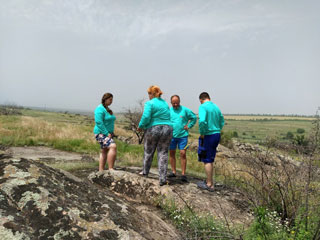The village of Tokivske belongs to the Hrushivska rural territorial community of the Kryvorizka district of the Dnipropetrovsk region. Unfortunately, it became known to many because of the mention in the news of numerous enemy shelling.
But today we will talk about the archaeological site “Tokivske 1”. The history of research began, as happens quite often, with the initiative of a person in love with his area. Local historian Y.I. Serhiychuk addressed the employees of the Dnipropetrovsk National Historical Museum named after D. I. Yavornytskyi with a request to verify evidence of the existence of remnants of a Cossack winter house of the 17th-18th centuries on the outskirts of the village. AD, which is being actively destroyed by the illegal actions of ancient seekers.
In November 2012, the archeological expedition of the museum (the head is O.V. Starik, Candidate of Science in Science) began work on the first floodplain terrace of the promontory on the right bank of the Kamyanka River in the north of Tokivskyi. According to information from the villagers, robbers using metal detectors found late medieval coins and other iron household items here. This allowed the local modern Cossacks to assume the existence of a winter camp at this place and even to install a granite obelisk with a three-leaf cross. Near the monument, the remains of the pioneer star formed from the soil have been preserved since Soviet times.
Among the entire array of finds from Tokivskyi-1, two closed complexes (treasures) of foundry molds of the Late Bronze Age, discovered during excavations in 2017–2018, are of particular interest. Assistance in their attribution was provided by D.P. Kushtan (Ph.D., senior researcher of the Department of Archeology of the Crimea and the North-Western Black Sea Region of the Institute of Archeology of the National Academy of Sciences of Ukraine). Attention is drawn to two one-sided wings of the double-winged form. The first – with negatives for casting a sickle and two round buttons-plates, the second – with negatives for casting sickles, a pin, a puncture, a chisel. An equally unique one-sided form with a lid, which was used for the production of a disc-shaped product (cream, plate decoration, mirror ???). In addition, two double-sided molds were found, which were used for casting daggers. Separately, let’s note the central element of the multi-bladed four-sided form, which was used for casting four tools at once: a flat adze and three dolts with a cast sleeve. The mineralogical and petrographic analysis of the raw material from which the foundry molds were made was performed by Dr. Geol. I.S. Nikitenko. It was determined that the rocks are represented by metaultrabases, the main minerals of which are anthophyllite, chlorite, and tremolite. The time of operation of the metalworking workshop in Tokivskyi can be determined from the 13th to the 12th centuries. B.C.
Tokiv complexes of foundry forms occupy an important place among such iconic sights of the Steppe and South of the Forest-Steppe Subdnipro region as Mali Kopani, Krasny Mayak, Chutivka, Dniprovokamyanka, Vyazozok, Voloske, Verkhnia Tarasivka, Novokiivka, etc. Most types of products are characteristic of the territory of the Dnieper region, although some find analogies in the wide expanses of Eurasia: from the Carpathians to Central Asia. This is an important evidence of cross-cultural ties and contacts between the populations of different regions during the Late Bronze Age, as well as an indicator of a high level of communication between them.


